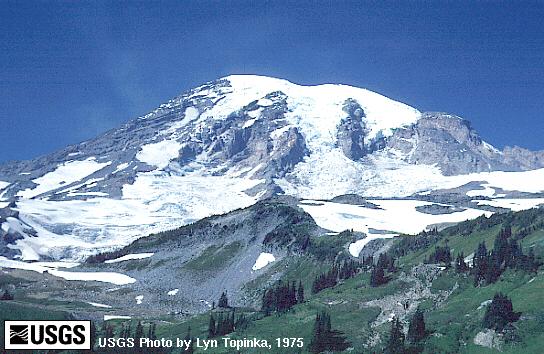"Cascade Range Summary"
Mount Rainier, Washington |
 Mount Rainier Volcano - "The Mountain":
Mount Rainier Volcano - "The Mountain":
Mount Rainier, the highest (4,392 meters - 14,410 feet) and third-most voluminous volcano in the Cascades after Mounts Shasta and Adams, dominates the Seattle-Tacoma area, where more than 1.5 million know it fondly as The Mountain. The Mountain is, however, the most dangerous volcano in the range, owing to the large population and to the huge area and volume of ice and snow on its flanks that could theoretically melt to generate debris flows during cataclysmic eruptions. -- Swanson, et.al., 1989 Mount Rainier Dominates the Landscape: Mount Rainier volcano dominates the landscape of a large part of western Washington. It stands nearly 3 miles higher than the lowlands to the west and 1.5 miles higher than the surrounding mountains. The base of the volcano spreads over an area of about 100 square miles, and lava flows that radiate from the base of the cone extend to distances of as much as 9 miles. The flanks of Mount Rainier are drained by five major rivers and their tributaries. Clockwise from the northwest the major rivers are the Carbon, White, Cowlitz, Nisqually, and Puyallup. Each river flows westerly through the Cascade Range and, with the exception of the Cowlitz, empties into Puget Sound near Tacoma, Washington. The Cowlitz joins the Columbia River in the southwestern part of the State to flow to the Pacific Ocean. -- Crandell, 1971 Eruptive Background: Mount Rainier is an active volcano that first erupted about half a million years ago. Because of Rainier's great height and northerly location, glaciers have cut deeply into its lavas, making it appear deceptively older than it actually is. Mount Rainier is known to have erupted as recently as in the 1840s, and large eruptions took place as recently as about 1,000 and 2,300 years ago. Mount Rainier and other similar volcanoes in the Cascade Range, such as Mount Adams and Mount Baker, erupt much less frequently than the more familiar Hawaiian volcanoes, but their eruptions are vastly more destructive. Hot lava and rock debris from Rainier's eruptions have melted snow and glacier ice and triggered debris flows (mudflows) - with a consistency of churning wet concrete - that have swept down all of the river valleys that head on the volcano. Debris flows have also formed by collapse of unstable parts of the volcano without accompanying eruptions. Some debris flows have traveled as far as the present margin of Puget Sound, and much of the lowland to the east of Tacoma and the south of Seattle is formed of pre-historic debris from Mount Rainier -- Sisson, 1995 Takhoma, Tahoma, Ta-co-bet, Rainier: Northwest American Indians knew the mountain long before European explorers reached the waters of the Pacific Ocean. For generations, they knew the mountain as Takhoma, Tahoma, Ta-co-bet and several other names. Many of the names mean "big mountain" or "snowy peak," or "place where the waters begin." Little Tahoma is the name of prominent rock outcrop on the east side of Mount Rainier. American Indians living both east and west of Mount Rainier traveled to the high mountain valleys each summer and fall to gather berries and hunt deer, goats, elk, and bear. They often camped near berry fields at altitudes between 3,000 feet and 5,000 feet. The forests and meadows around Mount Rainier were important summer hunting and gathering sites for the Nisqually, Puyallup, Upper Cowlitz, Muckleshoot, and Yakama people. On May 8, 1792, Captain George Vancouver of the British Royal Navy anchored his ship near today's Port Townsend, Washington. He wrote in his log, "... the round snowy mountain ... after my friend Rear Admiral Peter Rainier, I distinguished by the name of Mount Rainier ..." -- U.S. National Park Service, Mount Rainier National Park Website, 2002 MORE Mount Rainier:
News and Current Events, Research Updates, New Reports, Hazards Assessments:
|

